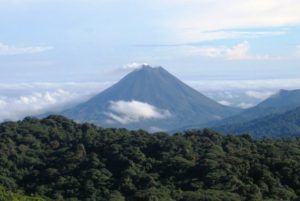 Rainy or Dry Season
Rainy or Dry Season
Costa Rica is praised for its tropical climate. Which varies from 65 to 90 degrees Fahrenheit depending on the region. Costa Rica is known for altitudinal variations from highland mountains to the low-lying coastline. The temperatures can fluctuate as much as 15-20 degrees within just a few hours drives. Most vacationers prefer to visit during the country’s summer months (December through April). Although rainy season visits offer plenty of advantages for the budget-minded traveler.
Click here and have the time of your life at our vacation villas!
Both seasons have benefits and drawbacks. The dry season early December to mid-April marks the start of Costa Rica’s peak tourism period. This is when beach vacation rentals, hotels and hostels begin booking up weeks in advance. Visitors are nearly guaranteed 12 hours of daily sunshine. Prices during this time are higher and popular attractions often crowded. It can rain daily in the green season. But do not fret thunderstorms typically roll in later in the day. The perks of a rainy season holiday include fewer tourists. Also, major savings on accommodations and increased flexibility with your travel.
Weather Zones
The Central Valley, Central Pacific region (Manuel Antonio), Southern Pacific, Caribbean, Northern Zone (includes Arenal/La Fortuna) and the Northern Pacific (Guanacaste region). Generally speaking, Guanacaste is the nation’s hottest and driest region. While the Caribbean and Northern Zones have consistent rainfall throughout the year.
The Central Valley
Encompassing the metropolitan San Jose area, Grecia, San Ramon, Alajuela, Atenas, Cartago, and other towns. The Central Valley enjoys annual spring-like temperatures that typically range between 70 and 75 degrees. This part of the country gets very little rain from late November through April, while September and October are the wettest months.
The Carribean
The Caribbean zone, which includes tourist hotspots like Tortuguero, Puerto Viejo, and Cahuita, has a distinct microclimate and different weather patterns than the rest of the country. This region is much more humid and prone to regular rains thanks to constant trade winds. As such, there is no set dry season, though March-April and September normally see less rain.
During Costa Rica’s summer months, coastal temperatures can reach the lower to mid-90s in Manuel Antonio, Jaco, Dominical, Tamarindo and other heavily-touristed beach towns. If visiting during December-January however, northerly trade winds keep day-time temperatures much more pleasant – usually around 85-88 degrees.
 Costa Rica Highlands
Costa Rica Highlands
Travelers to Arenal and Monteverde should expect day time temps hovering between 72-84 degrees, depending on altitude. Over at Chirripo Mountain is Costa Rica’s tallest peak at 12,533 feet. The mountain warrants thermal gear with temperatures rarely exceeding 65 F during the day, and dropping below freezing at night. Near the upper highland of the central valley, you will experience a cooler temperature. This is especially true the closer you get to the Volcanoes Irazu and Turrialba. Although you might need to bear through these cooler temperatures, you have the most amazing views. From the top of the mountains, you will be able to see the vast landscapes of Costa Rica.
Costa Rica certainly holds some amazing things for you to discover whether you come in the rainy or dry season. Let us know the next time you want to visit, we can help plan the best vacation possible.

 +1 888-818-2097
+1 888-818-2097
 +506 8932-4731
+506 8932-4731